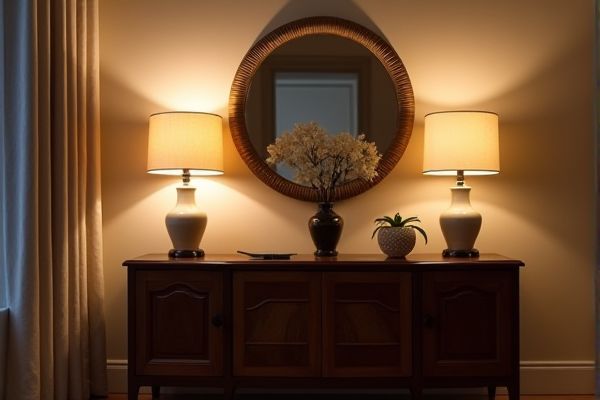
Buffet lamps provide ambient lighting and decorative accents typically on sideboards or dining room buffets, enhancing the room's atmosphere without overwhelming the space. Table lamps offer versatile, task-oriented illumination for desks, nightstands, or living areas, making them ideal for direct lighting needs; explore the rest of the article to determine which lamp best suits your lighting requirements.
Table of Comparison
| Feature | Buffet Lamps | Table Lamps |
|---|---|---|
| Typical Height | 18 to 30 inches | 12 to 30 inches |
| Primary Use | Accent lighting on sideboards or buffets | General or task lighting on desks, nightstands, or tables |
| Design | Narrow base, tall body to fit behind objects | Varies widely; generally shorter and wider base |
| Shade Style | Often tapered or drum shades, proportionate to height | Varies from drum to bell-shaped |
| Placement | Designed for buffet tables, sideboards, or consoles | Placed on bedside tables, desks, or living room tables |
| Light Output | Soft ambient or accent lighting | Task or ambient lighting depending on bulb and shade |
| Common Materials | Metal, glass, ceramic bases | Wood, metal, ceramic, glass bases |
| Power Source | Plug-in electric | Plug-in electric or battery operated |
Introduction: Buffet Lamps vs Table Lamps
Buffet lamps and table lamps both enhance lighting and decor but serve different purposes and styles. Buffet lamps typically feature elongated bases and taller shades, designed to illuminate dining rooms or buffets, while table lamps are more versatile, suitable for desks, nightstands, or living areas with varied sizes and designs. Choosing between a buffet lamp and a table lamp depends on Your space, lighting needs, and aesthetic preferences.
Defining Buffet Lamps
Buffet lamps are tall, slender fixtures designed to provide ambient lighting for dining rooms or living areas, typically placed on sideboards or buffet tables. Unlike traditional table lamps, buffet lamps focus on enhancing room ambiance with upward-directed light through fabric or glass shades. These lamps often feature dimmable settings and stylish bases that complement formal or contemporary decor while saving tabletop space.
Defining Table Lamps
Table lamps are versatile lighting fixtures designed primarily for task and ambient lighting, typically featuring a base, a stem, and a shade to diffuse light evenly. They are ideal for placement on desks, bedside tables, or sideboards, providing focused illumination tailored to activities like reading or working. Your choice between buffet lamps and table lamps hinges on the specific lighting needs and aesthetic preferences of your space.
Key Design Differences
Buffet lamps typically feature larger bases and taller, narrower shades designed to cast light downward on buffet tables or sideboards, enhancing dining areas with ambient illumination. Table lamps often have more varied shapes and sizes, with shades designed to diffuse light broadly for general room lighting or task work. The key design difference lies in the buffet lamp's emphasis on verticality and targeted lighting, while table lamps prioritize versatility and overall room brightness.
Common Uses and Placement
Buffet lamps are commonly placed on sideboards or buffets in dining rooms to provide warm, ambient lighting that enhances the atmosphere during meals. Table lamps are versatile and frequently positioned on bedside tables, desks, or living room end tables to offer task lighting and decorative accents. Your choice depends on the lighting needs and the specific area where illumination is required, balancing functionality and style.
Size and Proportion Comparison
Buffet lamps are generally taller, ranging from 28 to 36 inches, making them ideal for larger surfaces like sideboards or buffets, while table lamps typically stand between 24 to 30 inches, suited for bedside tables or desks. The proportion of buffet lamps is designed to complement expansive surfaces without overwhelming the space, whereas table lamps maintain a balanced scale for smaller, more intimate areas. When choosing the right lamp for your room, consider the height and width of the furniture to ensure proper visual harmony and functional lighting.
Lighting Effects and Ambiance
Buffet lamps provide soft, indirect lighting ideal for creating a warm and inviting ambiance in dining or living areas, often highlighting artwork or buffet surfaces without glare. Table lamps offer more focused, task-oriented light suitable for reading or working, with adjustable brightness levels that enhance functionality and atmosphere. Selecting between the two depends on desired lighting effects, with buffet lamps emphasizing ambient glow and table lamps emphasizing localized illumination.
Style and Décor Compatibility
Buffet lamps feature elongated designs and often provide softer illumination ideal for accentuating dining room or living room sideboards, complementing traditional or transitional decor styles. Table lamps come in a variety of shapes and sizes, offering versatile styling options that fit seamlessly into bedrooms, offices, or living spaces, enhancing contemporary, modern, or eclectic interiors. Choosing between buffet and table lamps depends on the room's function and desired ambiance, with buffet lamps focusing on subtle sophistication and table lamps emphasizing personalized style statements.
Pros and Cons of Buffet Lamps
Buffet lamps provide focused lighting ideal for dining areas and buffets, enhancing ambiance and visibility without consuming table space. Their tall, slender design offers elegant decor appeal but may limit illumination spread compared to table lamps. However, buffet lamps typically lack portability and versatility, making them less suitable for tasks requiring adjustable or movable light sources.
Pros and Cons of Table Lamps
Table lamps offer versatile lighting solutions ideal for reading, working, or accentuating room decor with their adjustable designs and variety of styles. Your space can benefit from their portability and targeted illumination, but they often require a flat surface and can occupy valuable table space. While table lamps provide focused light, their dependence on outlets and potential for clutter are notable trade-offs compared to buffet lamps.
 homyna.com
homyna.com